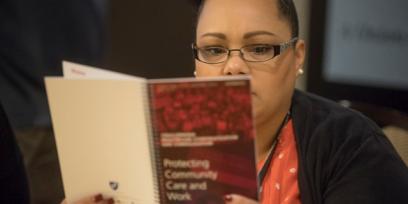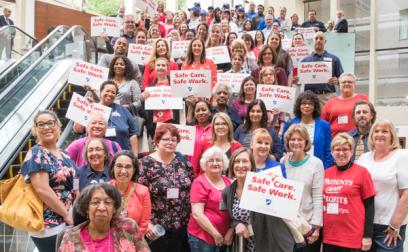In healthcare, corporatization and consolidation are on the rise, and nurses and health professionals are often the only ones standing between their communities and a healthcare system that puts profits and other interests ahead of patients. That’s why this year’s AFT Nurses and Health Professionals professional issues conference was brimming with ideas and solutions to address the issues connected to this trend. The AFT healthcare workers who gathered in Washington, D.C., April 25-27 were left with a challenge to ramp up their involvement as frontline advocates for themselves and their patients.
For several years now, we have been fighting against a relentless busting and bashing of unions, said AFT President Randi Weingarten, who spoke at the opening session of the conference. The fight has yielded a number of lessons, she said. “What we have as a labor movement is community, and in our community, we believe in fighting for a better life for others, not just for ourselves. Coming together as a group enables what is impossible for any one of us to do alone—and we get to do that when we negotiate or go to the bargaining table—that is what makes us different as a union.”
Unique challenges
A panel on the impact of healthcare corporatization and consolidation gave attendees strategies to deal with the changes they are seeing in their hospitals, which are affecting their work and their bargaining power.
Emily Gee, a health economist at the Center for American Progress, said the trend in consolidation is growing rapidly and is paired with the disappearance of independent hospitals. “This is happening despite evidence that bigger health systems are not performing better in terms of patient care and don’t provide better prices for patients,” Gee said. In fact, the high level of hospital consolidation is harming patients and their communities in the form of higher medical bills and out-of-pocket costs, less choice of providers and slower wage growth for healthcare workers. Gee offered ways to challenge consolidation, including working with policymakers to beef up the scrutiny of hospital mergers and pushing for greater transparency in medical billing.
Consolidation poses unique challenges for union members, said Eileen Appelbaum, co-director of the Center for Economic and Policy Research. The merger of hospitals into larger health systems increases employers’ bargaining power, and the movement of services to outpatient facilities makes organizing much more difficult, she said. “Understanding the impact on healthcare systems will help you do a better job of negotiating with management and addressing the challenges you face,” said Appelbaum.
Staffing: A universal concern
The conference also featured a panel on safe staffing, which is a universal concern for all healthcare workers. The panelists provided an overview of staffing research and discussed what members could do to address staffing issues at the state level.
Denise Duncan, president of the United Nurses Associations of California/Union of Health Care Professionals, spoke about how unions in California were able to make safe staffing ratios law. “Getting staffing ratios was hard work, but workers were able to do it with a grassroots campaign run by three nurse unions that worked together before the age of social media,” she said. The unions faced opposition from hospital management, who stoked fears that their hospitals would close if mandatory minimum staffing ratios were enacted. However, the nurses shared their stories, which resonated with community members. California is now the only state with legislated staffing ratios for nurses—although challenges still remain, more than a decade later. “Employers are constantly trying to beat them back with frequent violations and failing to budget for the ratios,” Duncan said. “We still have to bargain ratios to prevent delay, but it is getting harder for employers to deny that ratios work.”
Duncan told attendees that safe staffing ratios are possible with organizing. “Nurses must share their stories, especially on social media. Telling your story is the most powerful way to make fundamental change,” she said.
The three-day conference also featured a panel discussion on expanding healthcare access and coverage, where Georges Benjamin, executive director of the American Public Health Association, spoke about how healthcare workers can support strategies that provide high-quality affordable care at the state and federal level. Several conference workshops focused on advocating for patients and professional development. In addition, attendees had an opportunity to lobby their members of Congress to pass legislation to prevent workplace violence.
Brittany Mackey, a labor and delivery nurse at Providence Alaska Medical Center in Anchorage and a member of the Alaska Nurses Association, attended the conference for the first time. She found the workshops on resiliency from trauma and student debt most helpful. “Being able to bring programs and education back to our members will help us better deal with these issues,” Mackey said.
One of the biggest takeaways from the conference for Diane Jaulus, a social worker for the New York State Department of Corrections and a member of the New York State Public Employees Federation, was the realization that all the AFT’s nurses and health professionals have a common thread between them. “No matter where you are in the country, we all are in this to care for people and to make sure that we have a livable wage and job protections, and that there is someone we can count on to help to take care of us, and that is our union.”
Conference materials are available on AFT.org, along with photos from the event.
[Adrienne Coles]
 Member Benefits
Member Benefits Find Your Local
Find Your Local How to Join
How to Join En Espanol
En Espanol


